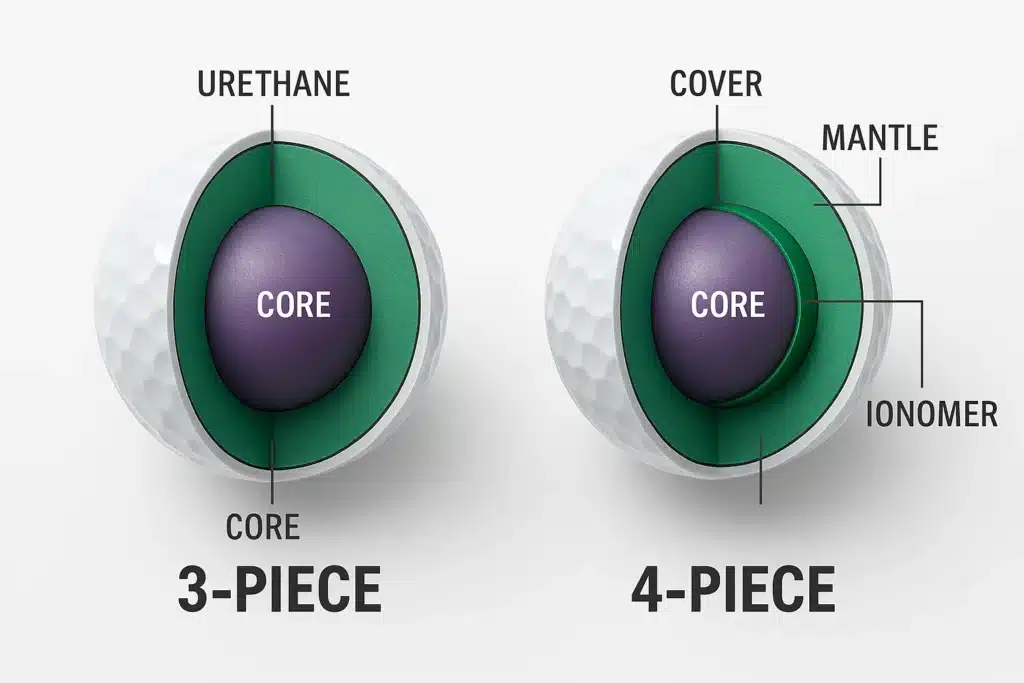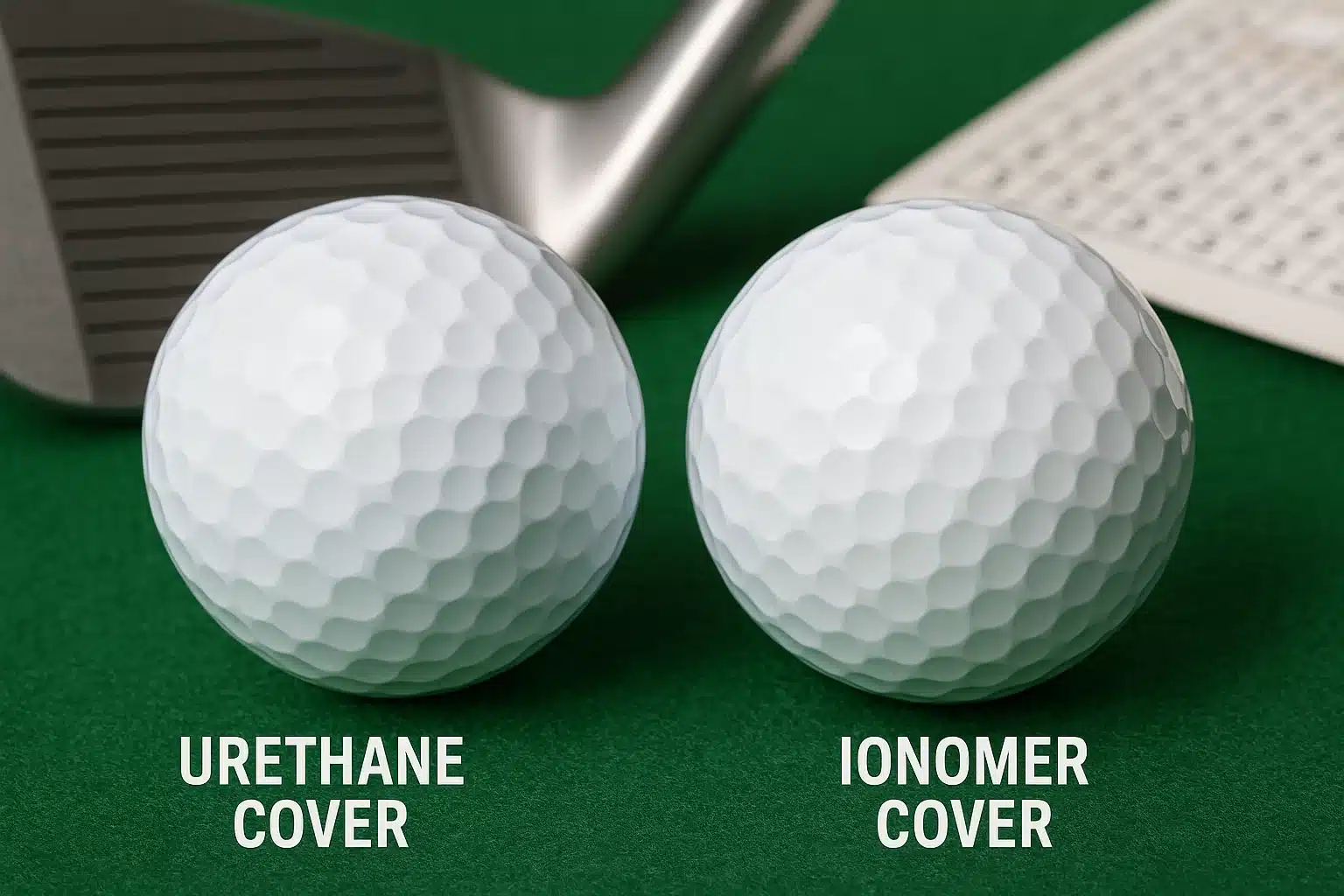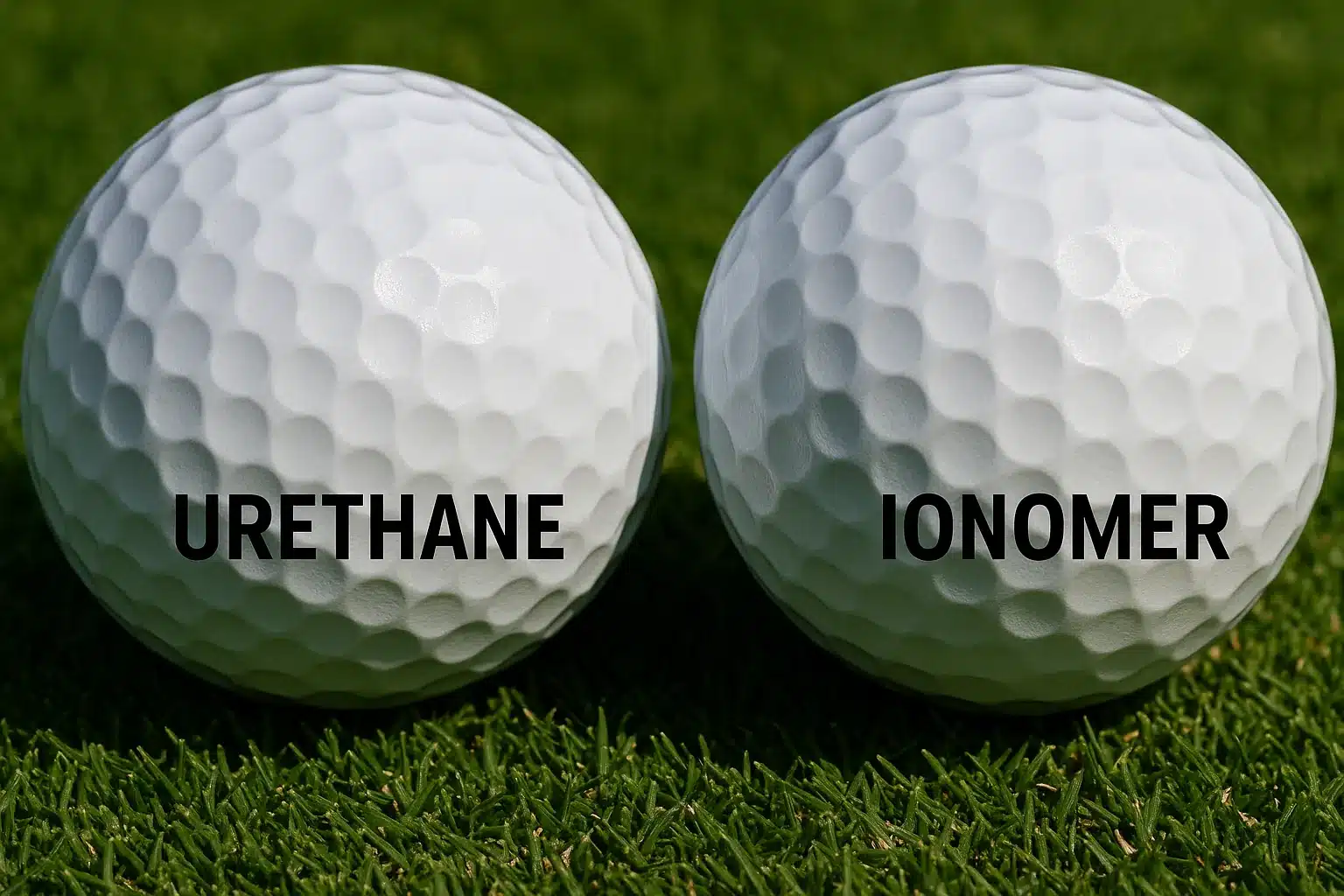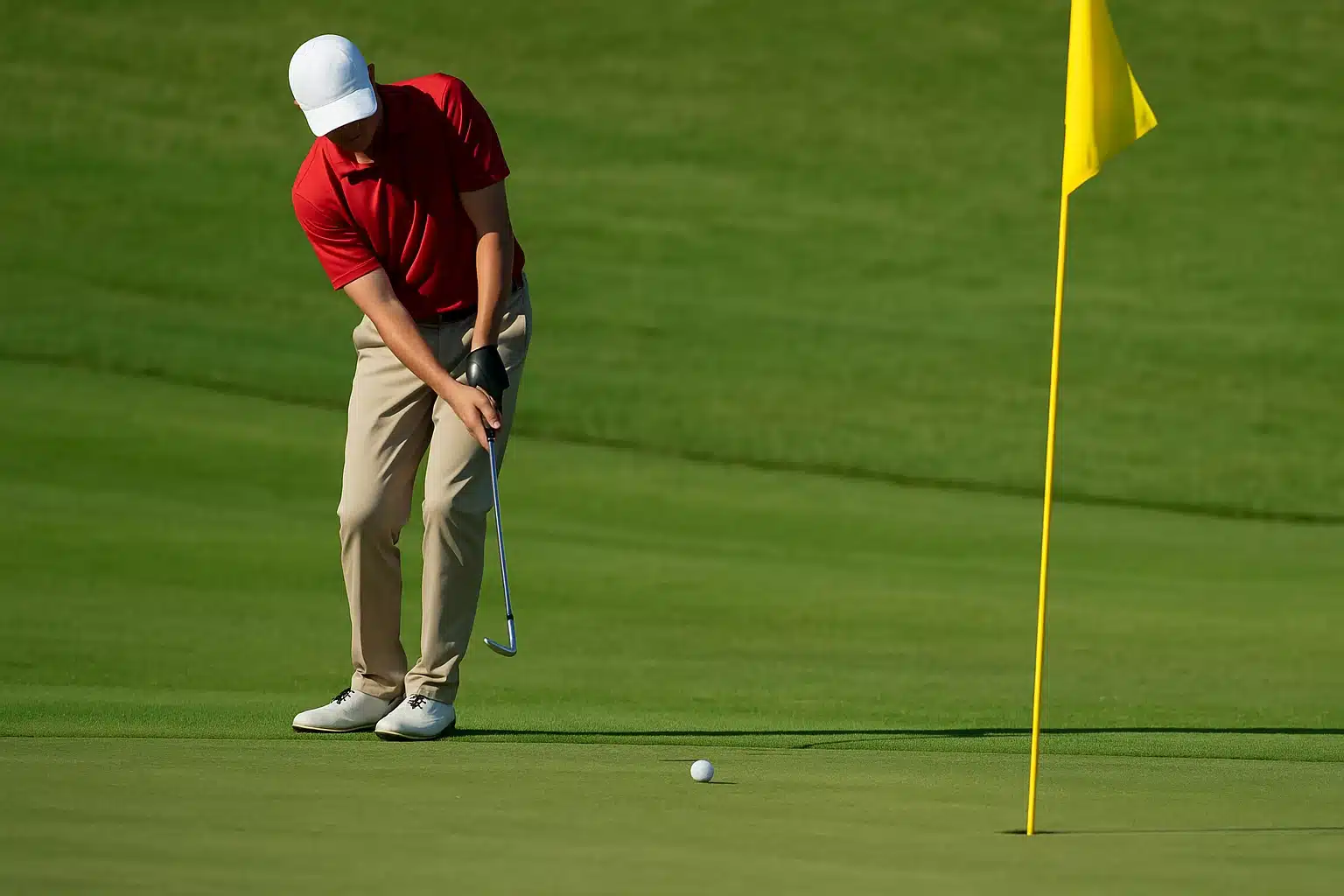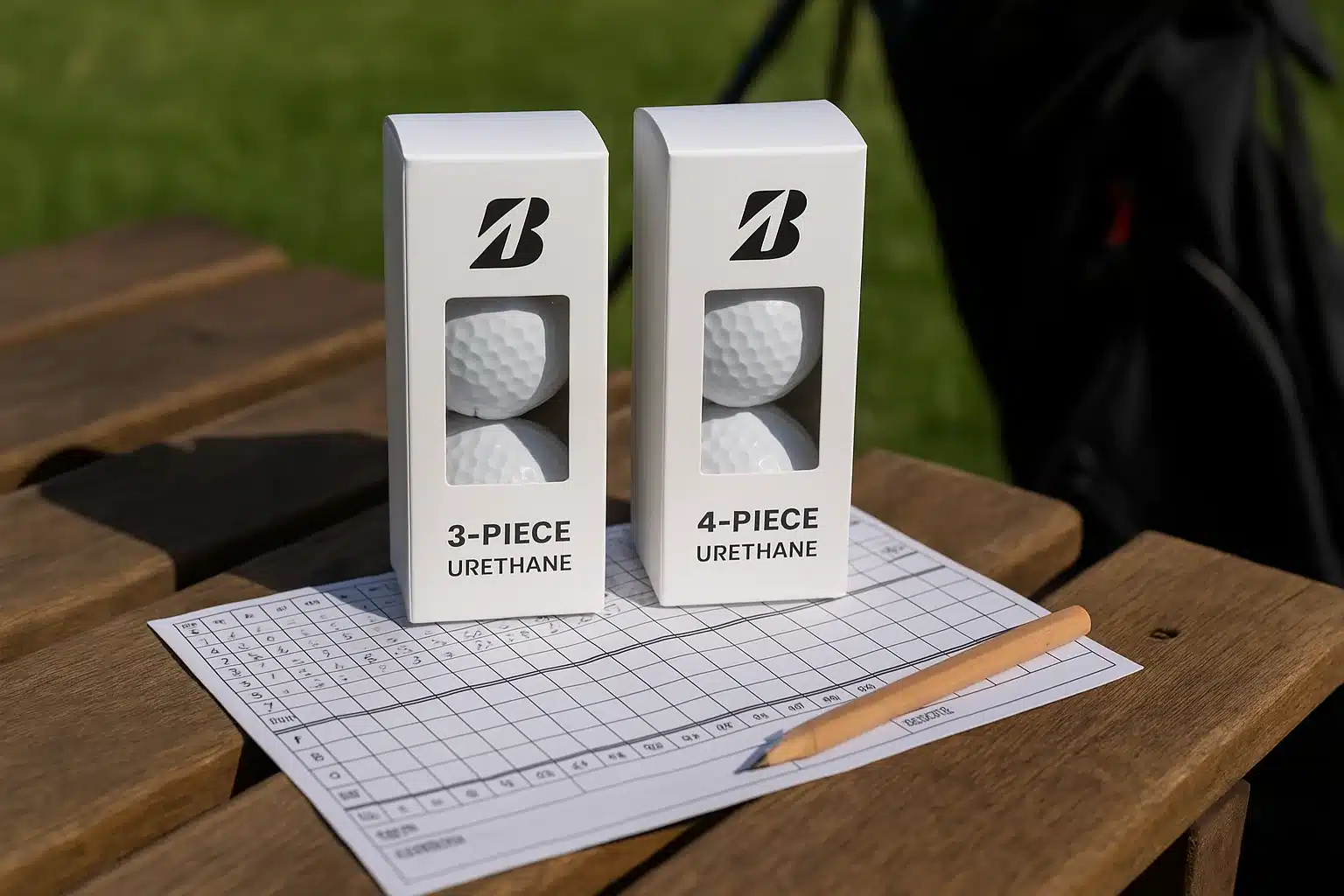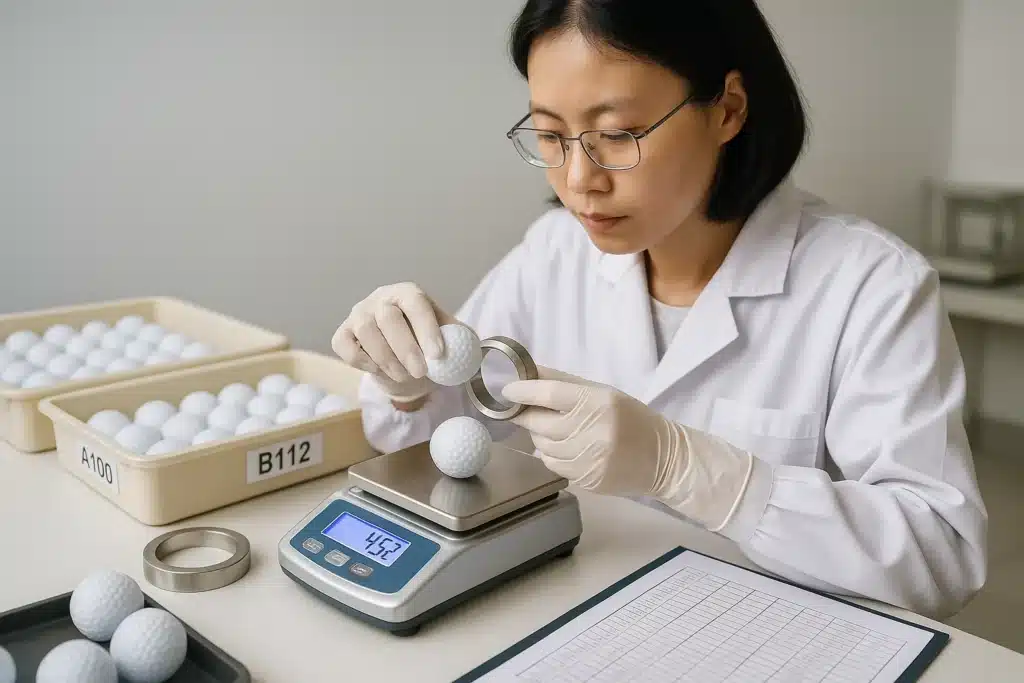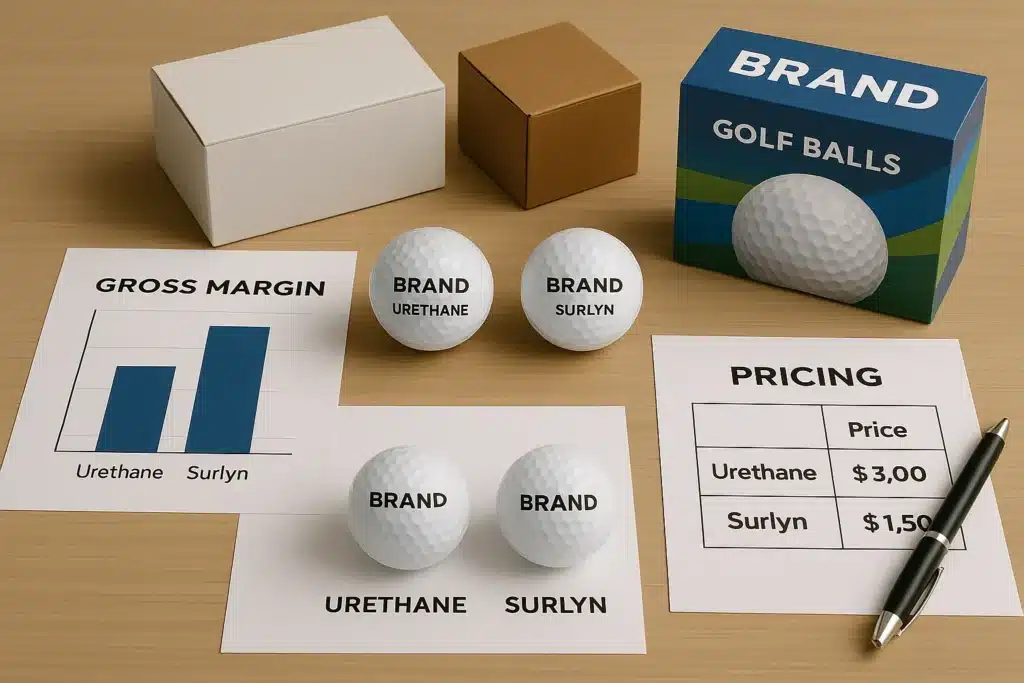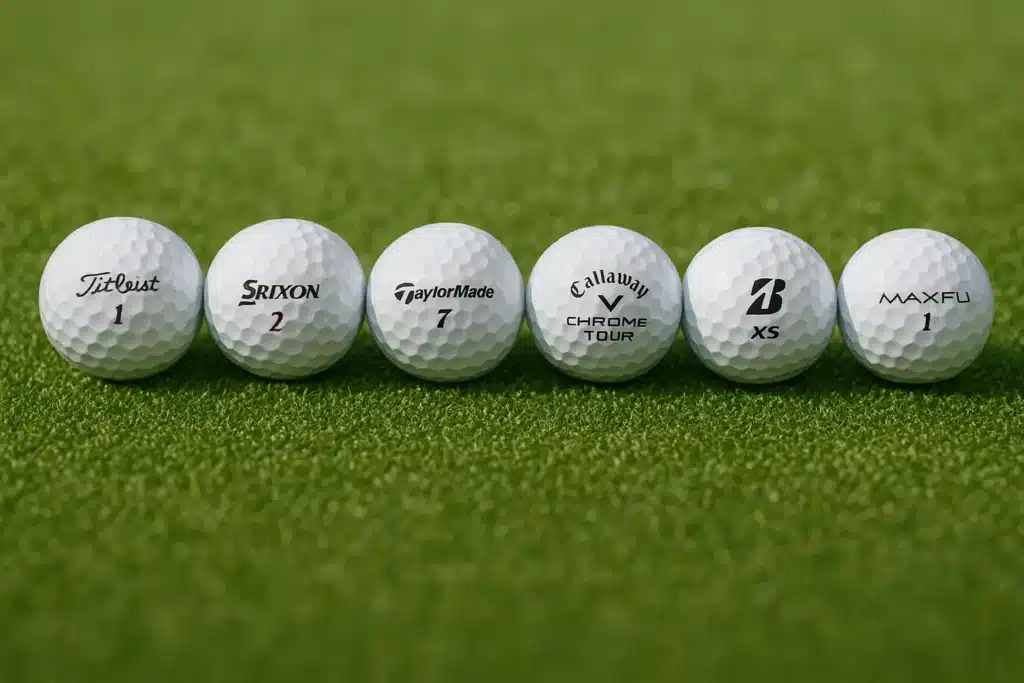A 3-piece golf ball blends distance, mid launch, and soft feel for most mid-handicaps with swing speeds under 100 mph. A 4-piece adds a mantle to create stronger spin separation—lower driver spin and higher short-iron spin—suited to fast swingers and firm greens. Urethane drives tour-level greenside spin; ionomer favors durability, straighter flight, and value.
What’s the quick comparison?
If you swing under 100 mph and want control without harsh feel, start with a 3-piece urethane. If you swing fast and prefer firm contact, higher flight, and sharper approach spin, go 4-piece. The cover material sets the category tone; layer count fine-tunes launch and spin windows for your delivery.
| Attribute | 3-Piece Golf Balls | 4-Piece Golf Balls |
|---|---|---|
| Typical Cover | Urethane or Ionomer | Mostly Urethane |
| Feel | Softer to medium | Medium-firm to firm |
| Driver Spin | Moderate | Lower |
| Iron/Wedge Spin | Moderate-high (urethane) | High |
| Trajectory | Mid | Mid-high |
| Best For | 85–100 mph; mid handicaps | 100+ mph; low handicaps |
| Price (dozen) | ~$30–$40 (urethane) | ~$45–$55 |
| Examples | Titleist Pro V1; TM Tour Response; Bridgestone e12 (ionomer) | Titleist Pro V1x; Callaway Chrome Tour X; TM TP5x |
Distance & driver spin
Distance gains come from the right launch and spin for your speed—not just more layers. At mid speeds, 3-piece urethane often hits the sweet spot: enough ball speed, stable launch, and manageable driver spin. At higher speeds, a 4-piece’s extra mantle can trim excess spin and tighten dispersion without sacrificing carry.
In practice, you chase “optimal” spin, not the lowest number. Too little spin can cause drop-outs and inconsistent carry. If your driver speed is ~88–98 mph, a 3-piece usually launches easier and forgives misses. At 100+ mph, a 4-piece can stabilize flight, especially in wind or with a left-to-right pattern.
Approach spin & feel
Greenside control is mostly cover-driven; feel stems from both cover and layer design. Urethane grips grooves at low impact speeds, raising chip and pitch spin. A 3-piece urethane feels a touch softer; a 4-piece tends to sound crisper and sit down faster with short irons—useful on firm greens or tucked pins.
Pick the feel that breeds confidence, then verify spin on-course. If you like a plush strike and mid flight, 3-piece is friendly. If you want sharp, fast-stopping approaches and don’t mind firmness, 4-piece lands steep and checks hard. Either way, test your common shots: half wedges, 8-iron, and tee ball.
✔ True — “Layer count changes spin windows”
Extra mantles can lower driver spin while maintaining or boosting short-iron spin, especially with urethane covers.
✘ False — “More layers automatically mean a better ball for everyone”
Without a matching swing speed and compression fit, extra layers may add cost without better scores.
Urethane or ionomer—which matters more?
The cover often matters more than layers. Urethane boosts greenside spin and soft feel across categories. Ionomer emphasizes durability, straighter flight, and lower cost. Choose the cover that fits your scoring needs first, then fine-tune with 3-piece vs 4-piece based on speed and feel.
| Feature | Urethane Cover | Ionomer (Surlyn) Cover |
|---|---|---|
| Short-Game Spin | High | Low–Moderate |
| Feel | Softer, premium | Firmer |
| Durability | Moderate | High |
| Flight Bias | Neutral | Straighter / lower spin |
| Typical Use | Tour / Players | Distance / Game Improvement |
Greenside difference
Urethane creates higher friction on chips and pitches, so it checks faster and stops closer. If you often face firm, sloped, or elevated greens, urethane’s extra bite helps. Your touch improves when sound/feel match what your hands expect on partials and putts.
If you mainly score with up-and-downs, invest here. The extra control can be worth more than five extra yards off the tee. For beginners, ionomer keeps costs sensible while you’re learning patterns—but plan to test urethane once dispersion tightens.
Durability & budget
Ionomer shrugging off cart paths is real; urethane can scuff sooner but pays you back in control. Many golfers win on value by gaming prior-gen urethane models. If you lose balls frequently or play tree-lined courses, ionomer’s toughness and price can stretch your budget without ruining fun.
Upgrade when your short game asks for it. Once you start flighting wedges to numbers, the incremental strokes saved by urethane can beat the replacement cost math—especially during competitive months.
Straighter flight use case
Lower spin from ionomer can calm side-spin-induced curve for some golfers. If slice or hook is your main issue, a 2-piece or 3-piece ionomer may keep you in more fairways while you work on mechanics. Later, mix in urethane sleeves as your pattern tightens.
Don’t over-correct. Too little spin can cause “floaters” that fall out of the sky. Track carry and curvature, not just total yards, and be honest about what helps you score on your course.
✔ True — “Material choice sets the category tone”
Tour balls are almost always urethane; value-oriented distance lines lean ionomer for toughness and price.
✘ False — “3-piece ionomer equals practice/non-conforming”
Conformity depends on USGA/R&A lists and tuning, not layer count or cover material alone.
How do layers really work?
Layers distribute impact energy and tune spin. The core sets compression and speed. Mantles act like “gearboxes,” shaping long-game spin and firmness. The cover controls greenside friction, durability, and sound. Faster swings activate deeper layers; slower or smoother swings may see better efficiency from simpler, softer builds.
Core & compression
The core is your engine: it sets compression, ball speed potential, and baseline feel. Higher-compression cores suit faster swings that fully compress the ball; lower-compression cores help moderate speeds launch higher with less effort. Compression isn’t a “hand-softness” metric—it’s how the ball responds at impact, not how it squishes in your fingers.
If you’re in the 85–100 mph range, mid compression is usually ideal. It lets you carry hazards without ballooning. Above ~100 mph, a firmer core resists over-compression, keeping spin in check. Pair that with the right mantle stack and you can chase a peak height that lands steep but doesn’t stall.
Mantles shape spin
Mantles are the spin managers; the second and (in 4-piece) third layers adjust long-game spin and firmness. With the right chemistries, engineers can trim driver spin while preserving iron spin. That’s why 4-piece balls appeal to faster swingers—they keep tee spin down but still grab on approaches and partials.
Too many mantles for a slow swing can hide the benefits. If you don’t create enough impact energy, inner layers don’t fully engage. That’s when a simpler 3-piece urethane often feels livelier and gives more consistent numbers on course, especially with mid-irons and half-wedges.
Cover controls greenside
Covers decide greenside bite. Urethane raises friction at low speeds; ionomer favors toughness and straighter flight. Around the green, urethane typically spins more and feels softer. Ionomer is quieter on the wallet and shrugs off cart paths better, but it won’t check as hard on delicate chips and flops.
Sound is feedback, and feedback is confidence. If a muted, soft click helps your distance control in putting and chipping, you’ll likely prefer urethane. If you value durability and a straighter ball flight off the long clubs, ionomer can be a smart choice in windy or tree-lined tracks.
When is a 3-piece the better pick?
Choose a 3-piece urethane when you want a friendly blend of distance, control, and softer feel—especially at 85–100 mph. It’s easier to launch, keeps driver spin manageable for most golfers, and usually costs less than 4-piece tour balls. Think “predictable, playable, good value.”
Who it fits
Mid-handicaps and smooth tempos benefit most: you’ll see consistent carry, mid flight, and trustworthy rollout. If you find firm balls harsh or hard to launch, a 3-piece urethane’s softer strike can stabilize contact and dispersion. It’s also forgiving when your path and face wander late in the round.
If your driver speed sits ~90–100 mph, start here. You’ll likely get more carry at your typical launch and not fight “low-spin floaters.” On medium-firm greens, you’ll still generate enough wedge bite to attack reasonable pins without fearing too much release.
Pros & trade-offs
Pros: softer feel, reliable spin, approachable price. Trade-offs: slightly higher driver spin vs 4-piece, and not quite the razor-sharp wedge grab elite players expect. That said, on real courses, the blend of control and forgiveness often saves more strokes than a firmer, faster-swing spec.
Think about your misses. If you fight spin-lofting the driver, a 4-piece could help. But if you fight thin or heel strikes, the friendlier strike window of many 3-piece urethanes will keep you in play more often and protect your scoring clubs.
Buyer Story — Toronto Retailer
I want to share a quick story about our client Dylan; three years ago he reached out us for a quote on golf balls—convinced a 4-piece “x” was the right launch for his premium house line at CAD 59.99. Instead of debating, we checked his data: most regulars swung 88–98 mph on medium-firm muni greens. We suggested a tuned 3-piece urethane and a one-day A/B with his customers.
Twenty-four golfers tested two sleeves. Seventy percent preferred the 3-piece for feel and predictable check; average dispersion tightened about 8%. The 3-piece also cut landed cost ~18%, letting him price at CAD 49.99 with a healthier margin. Eight weeks later, sell-through ran +22% versus plan. Then he added a 4-piece “x” as an upgrade for 102+ mph players. Dylan’s final note was short: “Keep the 3-piece coming.”
When is a 4-piece the better pick?
Choose a 4-piece when you swing 100+ mph and want firm feel, higher peak height, lower driver spin, and stronger approach stopping. The extra mantle sharpens spin separation for aggressive deliveries and windy conditions. Think “crisp flight, tight dispersion, quick stop.”
Who it fits
Low handicaps and assertive drivers who compress the ball deeply. If you routinely see too much tee spin or ballooning at high speed, a 4-piece can trim excess and keep curves tighter. On firm greens, the high spin window with scoring clubs pays off immediately.
If your speed is ~102–110+ mph, put 4-piece at the top of your list. It’s also a smart choice if you prefer a higher-flight window to carry trouble and land steeply—especially with long irons into par-5s.
Pros & trade-offs
Pros: lower tee spin at speed, sharper wedge grip, wind stability. Trade-offs: higher price, firmer sound, and muted gains for sub-100 mph swings. If you don’t compress the core, you won’t unlock the intended distance or separation—so test before you commit a season.
Models to sample. Titleist Pro V1x offers higher flight and firmer feel; Callaway Chrome Tour X blends penetrating long-game with high short-game spin; TaylorMade TP5x (a 5-layer) behaves like a firmer, fast-swing profile similar to many 4-pieces.
✔ True — “TP5x is a 5-layer design”
Its firmer, high-speed profile often overlaps with what players seek from many 4-piece ‘x’ balls—low driver spin and high approach spin.
✘ False — “TP5x equals a 4-piece ball”
It’s a distinct 5-layer construction that achieves similar on-course outcomes for fast swings.
Choose by speed, conditions & budget (with a 9-hole A/B test)
Start with your swing speed and feel preference, then check course conditions and budget. For many golfers, a 3-piece urethane hits the center of performance and value. Faster swings and firm greens tilt the board toward 4-piece. Confirm with a simple on-course A/B before you bulk-buy.
| Swing Speed | Handicap Tendency | Best Starting Point |
|---|---|---|
| <85 mph | Higher | 2-piece or soft 3-piece ionomer for distance and durability |
| 85–100 mph | Mid | 3-piece urethane for balanced spin, feel, and value |
| 100–110+ mph | Low | 4-piece (or 5-layer) urethane for low driver spin and strong approach spin |
On-course A/B test
A 9-hole A/B reveals your best match fast—no monitor needed. Use two sleeves from the same brand (e.g., Pro V1 vs Pro V1x) to isolate construction. Alternate balls. Track carry, dispersion width, approach stop, and chip check. Choose the ball with tighter patterns and predictable land-and-stop.
Keep simple notes. Mark fairways hit, miss direction, peak height, and rollout. On approaches, write how many paces you backed up or released. Around greens, note first-bounce check and total rollout. You’ll have a confident answer in one round.
Price bands & value
Budget smart: 3-piece urethane often sits at $30–$40/dozen; 4-piece tour balls at $45–$55. If you lose balls, ionomer stretches dollars; if firm greens punish release, urethane’s spin can save strokes. Prior-gen urethane is a value hack—tour-like feel without the newest MSRP.
| Category | Typical Price (Dozen) | Value Angle |
|---|---|---|
| 3-Piece Urethane | $30–$40 | Tour-like feel at friendly price |
| 4-Piece Urethane (Tour) | $45–$55 | Strong separation; premium QC |
| 3-Piece Ionomer | $20–$30 | Durable; straighter flight |
✔ True — “Fit beats spec sheets”
The right ball is the one that tightens your patterns and controls landing, not the one with the most layers.
✘ False — “The lowest tee spin always wins”
Too-low spin can cost carry and stability. Aim for optimal, not minimal, spin.
FAQ — what do golfers ask?
What’s the core difference in 3 piece vs 4 piece golf balls?
A 4-piece adds an extra mantle to reduce driver spin and enhance iron/wedge spin for fast swings. A 3-piece balances distance, launch, and feel. The cover—urethane vs ionomer—often influences your greenside spin more than layer count.
Which is better for average players?
Most golfers in the 85–100 mph range do best with 3-piece urethane: softer feel, predictable wedge check, and friendlier pricing. If you swing faster and like a firmer, higher-flight profile, test a 4-piece.
Do more layers mean more distance?
Not automatically. Distance comes from a good launch window and the right spin for your speed. If you don’t compress the core, extra layers won’t add yardage—and may even feel sluggish.
Are 4-piece balls only for pros?
No. They’re optimized for fast swings and low handicaps, but strong amateurs benefit too—if they compress the ball and prefer firmer feel with steep-landing approaches.
Is Pro V1 a 3-piece or 4-piece?
As of current models, Pro V1 is typically a 3-piece urethane and Pro V1x a 4-piece urethane; always check the latest spec sheet.
You might also like — Is It Possible to Buy Golf Balls Directly from a Chinese Manufacturer?

